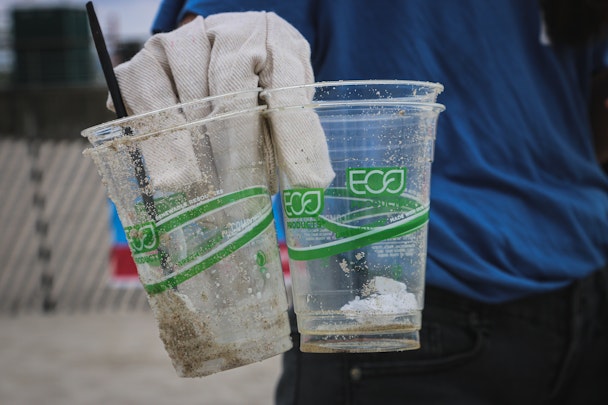You’re probably greenwashing, you just don’t know it
Greenwashing occurs when marketers use misleading information to convey an incorrect perception of an organization’s sustainability impact. We’re living in an age where brands that get it wrong are facing severe consumer backlash. Alicia Newman and Fiona Mcandrew, consultants at Frog – part of Capgemini – explore how greenwashing is merely the tip of the sustainability communications iceberg.

Frog on the role that greenwashing plays in sustainability communication
There are countless examples of brands missing the mark, from H&M’s ethical Conscious Collection, where one in five items were made from 100% fossil fuel-derived synthetics, to BMW, which misled consumers into thinking its new electric i3 was a zero-emissions ‘clean car.’ Increasingly, even more shocking examples have emerged, such as Korean brand Innisfree’s face serum, where the cardboard outer shell proudly stating ‘Hello, I’m Paper Bottle’ revealed a plastic bottle underneath once removed. The brand received backlash from consumers explaining their feelings of anger and betrayal, and this has clearly led to a loss in consumer trust – over half of US consumers ‘sometimes’ or ‘never’ believe companies’ environmental claims.
Evidently, greenwashing cuts across all industries and sectors, but why do so many organizations fall foul to this miscommunication and subsequent loss of consumer trust?
As marketers, we’re passionate about connecting with consumers on a different level, tapping into purpose-led meaningful topics that evoke emotion and resonance with the brand. However, passion can lead to overenthusiasm and – despite good intentions – content, creative and messaging can lead down an unexpectedly dark path.
To negate this, watchdogs such as the Competition and Markets Authority (CMA) have been set up to pull back the veil and shine a light on misconduct, forcing accountability on organizations. The CMA recently found that up to 40% of green claims could be greenwashing. A prime example of the CMA cracking its whip was in 2020 when Ryanair claimed it was ‘Europe’s lowest fares, lowest emissions airline,’ despite appearing in an EU report as one of Europe’s top 10 carbon emitters.
Clearly, we’re playing in a complex space where ‘getting it wrong’ can have a detrimental impact on an organization’s integrity and consumer trust. So how can organizations navigate this complex landscape?
According to Forrester’s report, customer understanding, brand strategy and clear campaign planning are the three key domains for marketers to address. Here is our take on these domains:
1. Customer insights: Consumers will always sit along a spectrum, and understanding which shade of green they fall into is key to shaping how, where and with what content you show them. Taking this approach helps identify key touchpoints along the consumer journey to evoke the right emotions and nudge consumers toward making more sustainable choices. Ekimetrics leverages artificial intelligence (AI) to reveal green consumer voices, helping marketers avoid miscommunication, and has built a green transition radar to uncover the truth behind environmental claims.
2. Brand and product strategy: Aligning your brand strategy and consumer perception with your sustainability claims is key to remaining authentic in this space. Working in siloed teams will never equate to success. Organizations need to build a panel of key internal stakeholders (eg R&D, product, operations, marketing, finance) and external stakeholders (eg clients, NGOs) to co-create high-level brand and product strategy shifts.
Toast Ale built a broad network of partners (including competitors) to define an authentic sustainability strategy. Its Companion series partnered with 25 breweries to create a limited-edition collection of beers that use surplus bread with the aim to reduce food waste, and called for governments to take similar collaborative action. Another great example of an integrated brand and product strategy comes from Lego, which listened to its consumers’ frustrations around petroleum-based plastic and has partnered with organizations such as the World Wildlife Fund to source new materials such as sugarcane to drive its new innovative product strategy.
3. Campaign and agency briefing: Oversimplification frequently leads to greenwashing. In 2021, Oatly created an ad campaign comparing the carbon footprint of Oatly’s oat milk to cow’s milk. After 109 complaints to the Advertising Standards Authority (ASA), Oatly was unable to provide the evidence needed to substantiate the complaints. This could have been avoided had Oatly inputted clear guidelines around how to shape content and messaging throughout the campaign and agency briefing process. Despite the ASA beginning to publish key guidelines and free training resources, brands need to leverage, adapt and mandate this guidance internally to avoid misinterpretation and subsequent greenwashing.
The sustainability communications iceberg is a tricky area to crack. Organizations need to reset their approach to sustainability marketing, realign their brand strategy to be embedded in authenticity, rethink guidelines around campaign planning and, as always, place the customer at the heart of their approach. Only then will the iceberg begin to melt, ironically, enabling the organization to move away from greenwashing to authentic sustainability marketing.
We, along with other companies, were interviewed by Forrester for one of their latest reports, ‘From Greenwashing To Best Practices On Sustainability Communications.’ To find out more, you can access the full report here (available to Forrester subscribers or for purchase).
To learn more about Frog, part of Capgemini Invent, visit our site and get in touch.
Content by The Drum Network member:

frog
frog is a leading global creative consultancy, part of Capgemini Invent. Partnering with passionate leaders and visionary entrepreneurs, we apply creativity, strategy,...
Find out more
